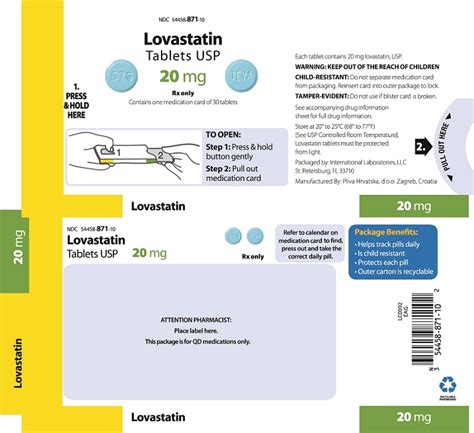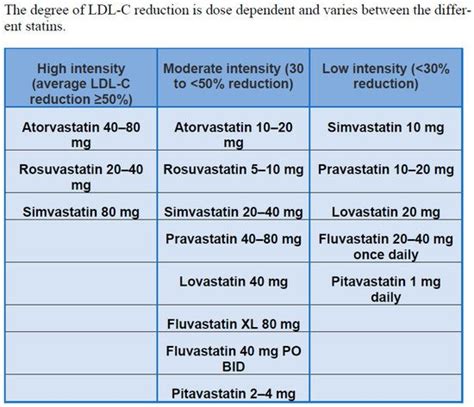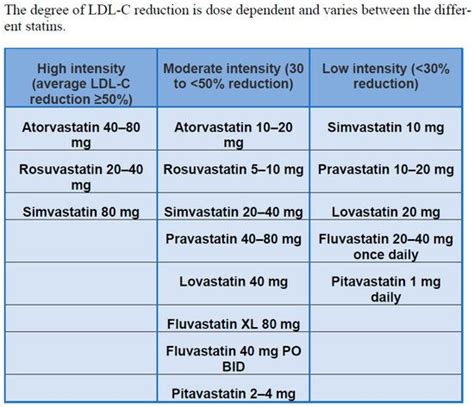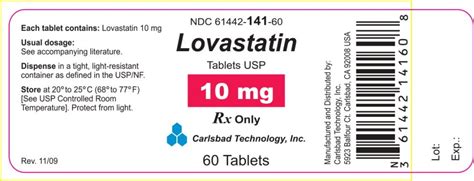Intro
Discover 7 Lovastatin side effects, including muscle pain, liver damage, and cognitive issues, and learn how to manage statin-related risks, interactions, and benefits for cholesterol reduction.
Lovastatin is a medication that belongs to the statin class, which is commonly used to lower cholesterol levels in the blood. It works by inhibiting the enzyme HMG-CoA reductase, which plays a key role in the production of cholesterol in the liver. While lovastatin is generally effective in reducing cholesterol levels and preventing cardiovascular disease, it can cause several side effects. In this article, we will discuss the common and rare side effects of lovastatin, as well as the importance of monitoring and managing these side effects.
The use of lovastatin has become increasingly widespread due to the rising prevalence of high cholesterol and cardiovascular disease. As a result, it is essential to understand the potential side effects of this medication and take steps to minimize their impact. By being aware of the possible side effects of lovastatin, individuals can take a proactive approach to managing their health and reducing the risk of complications.
Lovastatin is often prescribed in combination with lifestyle modifications, such as a healthy diet and regular exercise, to achieve optimal cholesterol levels. While the benefits of lovastatin in reducing cardiovascular risk are well-established, the potential side effects should not be overlooked. In the following sections, we will delve into the common and rare side effects of lovastatin, as well as the mechanisms underlying these effects.
Lovastatin Side Effects Overview

Common Lovastatin Side Effects
The common side effects of lovastatin include: * Muscle pain or weakness * Liver enzyme elevations * Nausea and vomiting * Diarrhea or constipation * Headache * Dizziness or lightheadedness * Fatigue or weakness These side effects are usually mild and temporary, but they can be bothersome for some individuals. In most cases, the benefits of lovastatin in reducing cholesterol levels and preventing cardiovascular disease outweigh the risks of these side effects.Rare but Serious Lovastatin Side Effects

Lovastatin and Muscle Damage
Muscle damage or rhabdomyolysis is a rare but serious side effect of lovastatin. This condition occurs when the muscle tissue breaks down, releasing enzymes and other substances into the bloodstream. Symptoms of muscle damage include: * Severe muscle pain or weakness * Dark urine or tea-colored urine * Fatigue or weakness * Abdominal pain or nausea If left untreated, muscle damage can lead to kidney failure and other complications.Lovastatin and Liver Enzyme Elevations

Managing Lovastatin Side Effects
To minimize the risk of side effects, it is essential to follow the recommended dosage and monitoring schedule for lovastatin. This includes: * Regular blood tests to monitor liver enzyme levels and cholesterol levels * Regular check-ups with a healthcare provider to monitor for side effects * Reporting any concerns or symptoms to a healthcare provider promptly * Avoiding grapefruit or grapefruit juice, which can increase the risk of side effects * Taking lovastatin with food to reduce the risk of gastrointestinal side effectsLovastatin Interactions and Contraindications

Lovastatin Contraindications
Lovastatin is contraindicated in individuals with: * Active liver disease or liver failure * Pregnancy or breastfeeding * Hypersensitivity to lovastatin or other statin medications * Muscle disease or muscle damage * Uncontrolled seizures or epilepsyLovastatin Dosage and Administration

Lovastatin and Pregnancy
Lovastatin is contraindicated in pregnancy due to the risk of fetal harm. Statin medications can cause birth defects or other complications in the developing fetus. Women of childbearing age should use effective contraception while taking lovastatin and inform their healthcare provider if they become pregnant or plan to become pregnant.Lovastatin and Breastfeeding

Lovastatin and Geriatric Use
Lovastatin can be used in geriatric patients, but with caution. Older adults may be more susceptible to the side effects of lovastatin, particularly muscle damage and liver enzyme elevations. Regular monitoring and dose adjustments may be necessary to minimize the risk of side effects.Lovastatin and Pediatric Use

Lovastatin and Renal Impairment
Lovastatin can be used in patients with renal impairment, but with caution. Patients with severe renal impairment may require dose adjustments to minimize the risk of side effects.Lovastatin and Hepatic Impairment

Conclusion and Final Thoughts
In conclusion, lovastatin is a commonly used medication for reducing cholesterol levels and preventing cardiovascular disease. While it can cause several side effects, the benefits of lovastatin often outweigh the risks. By being aware of the potential side effects and taking steps to minimize their impact, individuals can use lovastatin safely and effectively. It is essential to work closely with a healthcare provider to monitor for side effects and adjust the treatment plan as needed.We invite you to share your thoughts and experiences with lovastatin in the comments below. If you have any questions or concerns about lovastatin or its side effects, please do not hesitate to ask. Your feedback is valuable to us, and we look forward to hearing from you.
What are the common side effects of lovastatin?
+The common side effects of lovastatin include muscle pain, liver enzyme elevations, nausea, vomiting, diarrhea, constipation, headache, dizziness, and fatigue.
Can lovastatin cause muscle damage?
+Yes, lovastatin can cause muscle damage or rhabdomyolysis, which is a rare but serious side effect. Symptoms of muscle damage include severe muscle pain, dark urine, fatigue, and abdominal pain.
Is lovastatin safe during pregnancy?
+No, lovastatin is contraindicated in pregnancy due to the risk of fetal harm. Statin medications can cause birth defects or other complications in the developing fetus.
Can lovastatin be used in geriatric patients?
+Yes, lovastatin can be used in geriatric patients, but with caution. Older adults may be more susceptible to the side effects of lovastatin, particularly muscle damage and liver enzyme elevations.
Is lovastatin available in generic form?
+Yes, lovastatin is available in generic form, which can be more affordable than the brand-name version.
